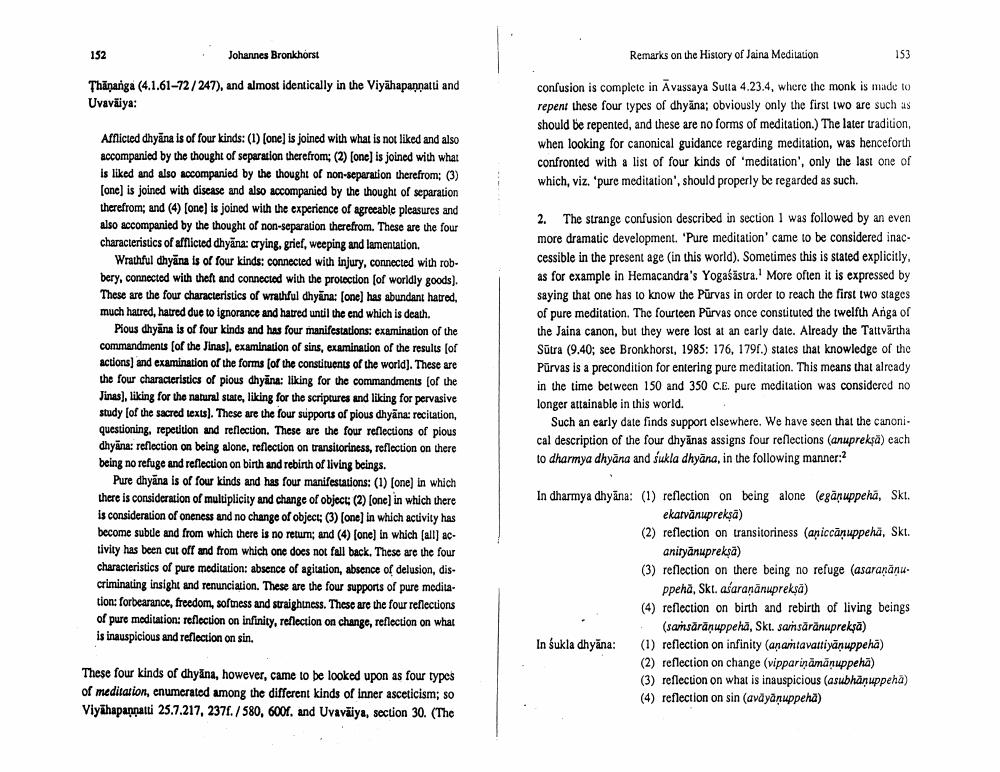Book Title: Remarks On History Of Jaina Meditation Author(s): Johannes Bronkhorst Publisher: Johannes Bronkhorst View full book textPage 2
________________ 152 Johannes Bronkhorst Remarks on the History of Jaina Meditation 153 Thānanga (4.1.61-72/247), and almost identically in the Viyahapannatul and Uvaväiya: confusion is complete in Avussaya Sulta 4.23.4, where the monk is made to repent these four types of dhyāna; obviously only the first two are such as should be repented, and these are no forms of meditation. The later tradition, when looking for canonical guidance regarding meditation, was henceforth confronted with a list of four kinds of meditation', only the last one of which, viz. 'pure meditation, should properly be regarded as such. Afficted dhyāna is of four kinds: (1) (one) is joined with what is not liked and also accompanied by the thought of separation therefrom: (2) [onc] is joined with what Is liked and also accompanied by the thought of non-separation therefrom; (3) (one) is joined with discase and also accompanied by the thought of separation therefrom; and (4) (one) is joined with the experience of agreeable pleasures and also accompanied by the thought of non-separation therefrom. These are the four characteristics of afflicted dhyāna: aying, grief, weeping and lamentation Wrathful dhyāna is of four kinds: connected with injury, connected with robbery, connected with theft and connected with the protection for worldly goods). These are the four characteristics of wrathful dhyana: (one) has abundant hatred, much hatred, hatred due to ignorance and hatred until the end which is death. Pious dhyāna is of four kinds and has four manifestations: examination of the commandments for the Jinas), examination of sins, examination of the results for actions) and examination of the forms (or the constituents of the world). These are the four characteristics of pious dhyāna: liking for the commandments for the Jinas), liking for the natural state, liking for the scriptures and liking for pervasive study of the sacred texts). These are the four supports of pious dhyana: recitation, uestioning, repeution and reflection. These are the four reflections of pious dhyāna: reflection on being alone, reflection on transitoriness, reflection on there being no refuge and reflection on birth and rebirth of living beings. Pure dhyāna is of four kinds and has four manifestations: (1) (one) in which there is consideration of multiplicity and change of object: (2) (one) in which there is consideration of oneness and no change of object; (3) (one) in which activity has become subue and from which there is no return; and (4) (one) in which (all) ac tivity has been cut off and from which one does not fall back. These are the four characteristics of pure meditation: absence of agitation, absence of delusion, discriminating insight and renunciation. These are the four supports of pure meditation: forbearance, freedom, softness and straightness. These are the four relections of pure meditation: relection on infinity, reflection on change, reflection on what is inauspicious and reflection on sin. 2. The strange confusion described in section 1 was followed by an even more dramatic development. 'Pure meditation came to be considered inac. cessible in the present age (in this world). Sometimes this is slated explicitly. as for example in Hemacandra's Yogaśāstra. More often it is expressed by saying that one has to know the Pūrvas in order to reach the first two stages of pure meditation. The fourteen Purvas once constituted the twelfth Anga of the Jaina canon, but they were lost at an carly date. Already the Tattvärtha Sūtra (9.40; see Bronkhorst, 1985: 176, 1791.) states that knowledge of the Purvas is a precondition for entering pure meditation. This means that already in the time between 150 and 350 C.E. pure meditation was considered no longer attainable in this world. Such an early date finds support elsewhere. We have seen that the canoni. cal description of the four dhyānas assigns four reflections (anupreksä) each to dharmya dhyana and sukla dhyāna, in the following manner: In dharmya dhyana: (1) reflection on being alone (egar uppeha, Skt. ekarvanspreksā) (2) reflection on transitoriness (aniccaruppehå, Skt. anityānupreksā) (3) reflection on there being no refuge (asaranānu. ppeha, Skt. asaraṇānupreksā) (4) reflection on birth and rebirth of living beings (samsărānuppeha, Skt. sansárānuprekrā) In sukla dhyāna: (1) reflection on infinity (anantavattiyānuppeha) (2) reflection on change (vippariņāmānuppehā) (3) reflection on what is inauspicious (asubhanuppeha) (4) reflection on sin (avāyānuppeha) These four kinds of dhyāna, however, came to be looked upon as four types of meditation, enumerated among the different kinds of Inner asceticism; 50 Viyahapannatui 25.7.217, 237f./580, 6001. and Uvaväiya, soction 30. (ThePage Navigation
1 2 3 4 5 6 7
